An Analysis of the Role of Change Agents in Organizations
VerifiedAdded on 2021/06/16
|10
|2683
|24
Report
AI Summary
This report delves into the critical role of change agents within organizational change management. It begins by defining change agents and their responsibilities, highlighting their importance in initiating and coordinating change efforts, and differentiating between internal and external agents. The report then presents a critical review of existing literature, discussing the advantages and disadvantages of employing change agents, and analyzing the challenges they face, such as resistance to change and the need for effective communication. The analysis covers various aspects of change agent roles, including consulting, training, and research functions, and emphasizes the importance of leadership and communication in successful change implementation. The report concludes by summarizing the key findings and reiterating the significant impact of change agents on organizational development and the achievement of long-term objectives. The report also discusses the theories used by change agents like Lippitt change theory, social cognitive theory, Lewin’s three step theory and Havelock’s theory.
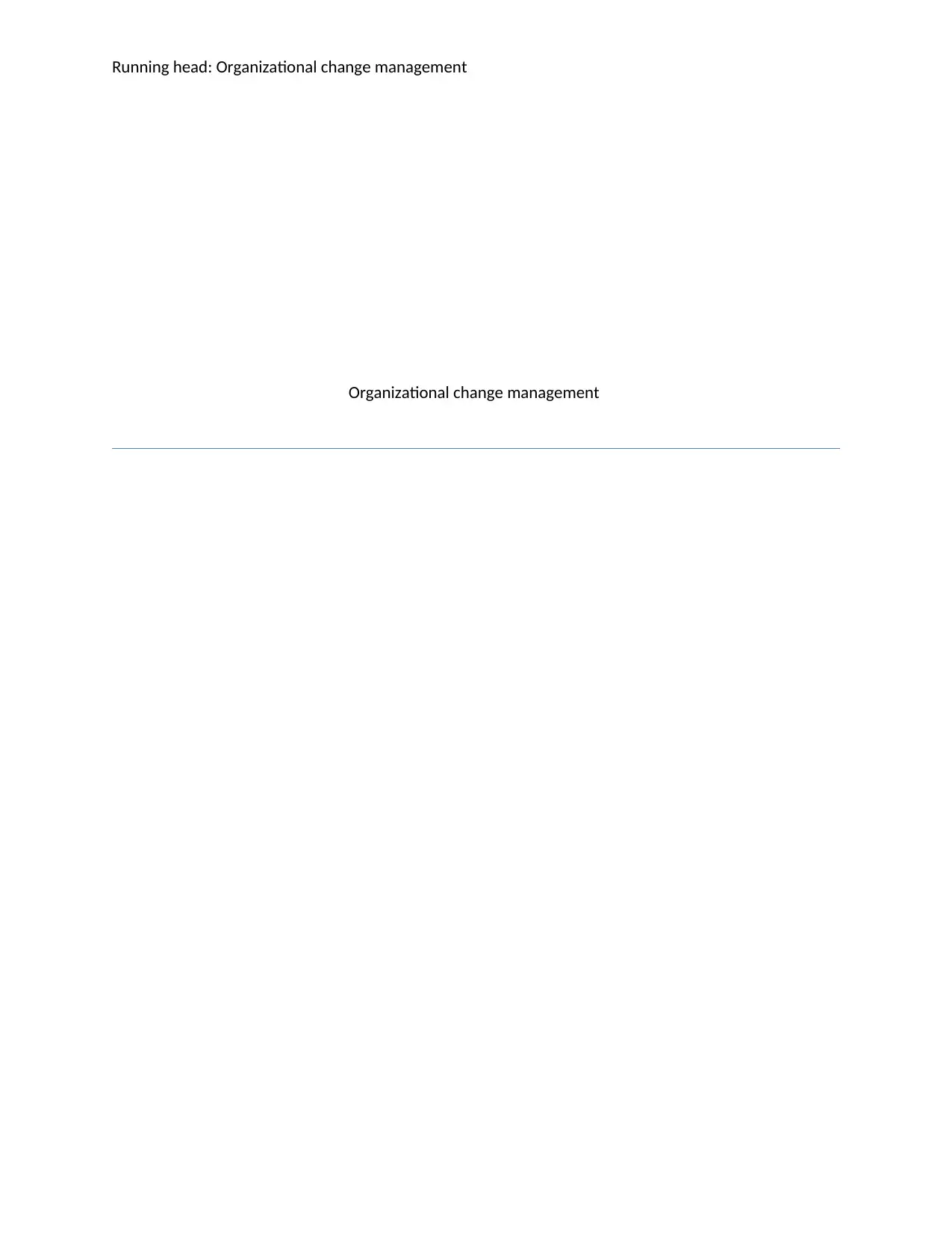
Running head: Organizational change management
Organizational change management
Organizational change management
Paraphrase This Document
Need a fresh take? Get an instant paraphrase of this document with our AI Paraphraser
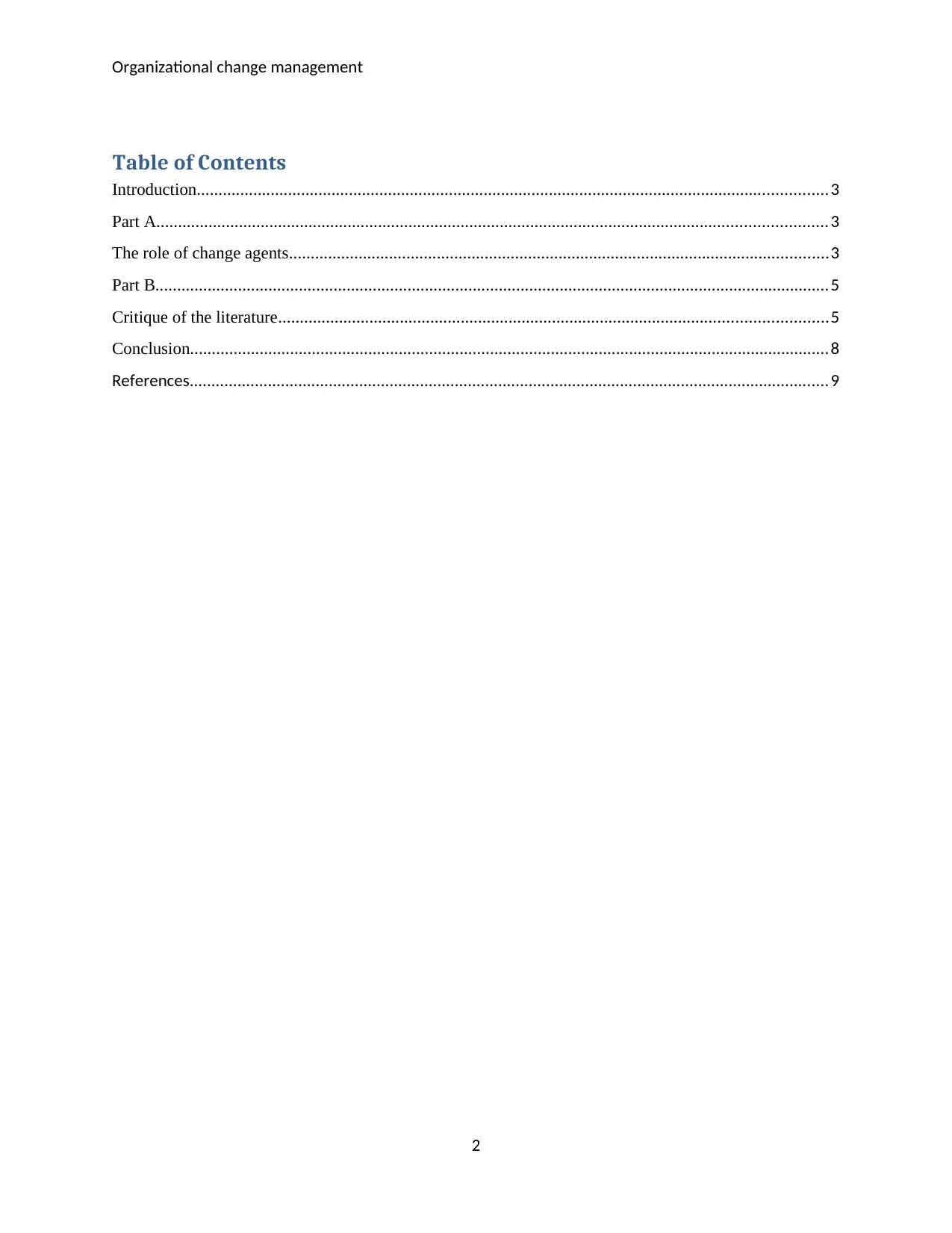
Organizational change management
Table of Contents
Introduction.................................................................................................................................................3
Part A..........................................................................................................................................................3
The role of change agents............................................................................................................................3
Part B...........................................................................................................................................................5
Critique of the literature..............................................................................................................................5
Conclusion...................................................................................................................................................8
References...................................................................................................................................................9
2
Table of Contents
Introduction.................................................................................................................................................3
Part A..........................................................................................................................................................3
The role of change agents............................................................................................................................3
Part B...........................................................................................................................................................5
Critique of the literature..............................................................................................................................5
Conclusion...................................................................................................................................................8
References...................................................................................................................................................9
2
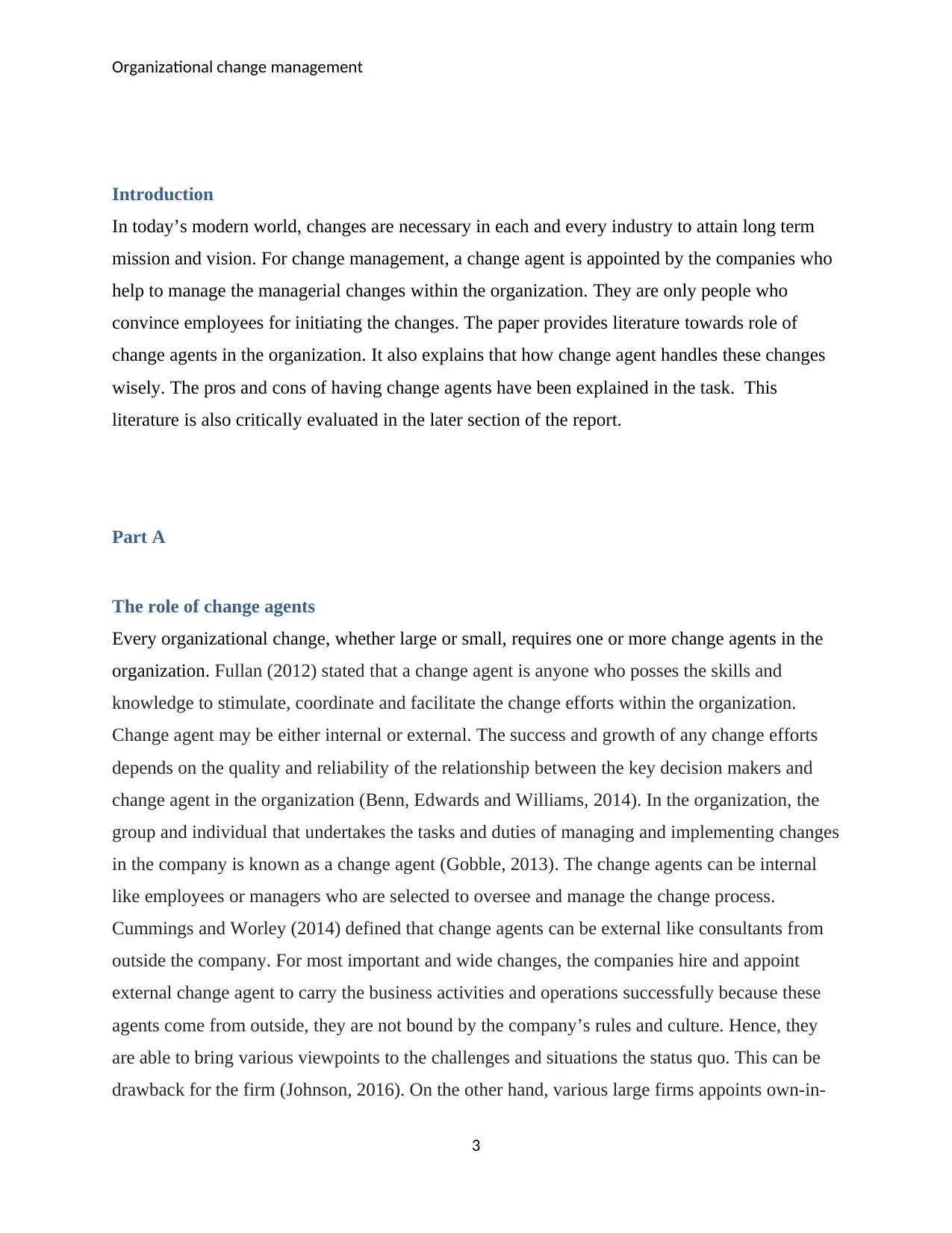
Organizational change management
Introduction
In today’s modern world, changes are necessary in each and every industry to attain long term
mission and vision. For change management, a change agent is appointed by the companies who
help to manage the managerial changes within the organization. They are only people who
convince employees for initiating the changes. The paper provides literature towards role of
change agents in the organization. It also explains that how change agent handles these changes
wisely. The pros and cons of having change agents have been explained in the task. This
literature is also critically evaluated in the later section of the report.
Part A
The role of change agents
Every organizational change, whether large or small, requires one or more change agents in the
organization. Fullan (2012) stated that a change agent is anyone who posses the skills and
knowledge to stimulate, coordinate and facilitate the change efforts within the organization.
Change agent may be either internal or external. The success and growth of any change efforts
depends on the quality and reliability of the relationship between the key decision makers and
change agent in the organization (Benn, Edwards and Williams, 2014). In the organization, the
group and individual that undertakes the tasks and duties of managing and implementing changes
in the company is known as a change agent (Gobble, 2013). The change agents can be internal
like employees or managers who are selected to oversee and manage the change process.
Cummings and Worley (2014) defined that change agents can be external like consultants from
outside the company. For most important and wide changes, the companies hire and appoint
external change agent to carry the business activities and operations successfully because these
agents come from outside, they are not bound by the company’s rules and culture. Hence, they
are able to bring various viewpoints to the challenges and situations the status quo. This can be
drawback for the firm (Johnson, 2016). On the other hand, various large firms appoints own-in-
3
Introduction
In today’s modern world, changes are necessary in each and every industry to attain long term
mission and vision. For change management, a change agent is appointed by the companies who
help to manage the managerial changes within the organization. They are only people who
convince employees for initiating the changes. The paper provides literature towards role of
change agents in the organization. It also explains that how change agent handles these changes
wisely. The pros and cons of having change agents have been explained in the task. This
literature is also critically evaluated in the later section of the report.
Part A
The role of change agents
Every organizational change, whether large or small, requires one or more change agents in the
organization. Fullan (2012) stated that a change agent is anyone who posses the skills and
knowledge to stimulate, coordinate and facilitate the change efforts within the organization.
Change agent may be either internal or external. The success and growth of any change efforts
depends on the quality and reliability of the relationship between the key decision makers and
change agent in the organization (Benn, Edwards and Williams, 2014). In the organization, the
group and individual that undertakes the tasks and duties of managing and implementing changes
in the company is known as a change agent (Gobble, 2013). The change agents can be internal
like employees or managers who are selected to oversee and manage the change process.
Cummings and Worley (2014) defined that change agents can be external like consultants from
outside the company. For most important and wide changes, the companies hire and appoint
external change agent to carry the business activities and operations successfully because these
agents come from outside, they are not bound by the company’s rules and culture. Hence, they
are able to bring various viewpoints to the challenges and situations the status quo. This can be
drawback for the firm (Johnson, 2016). On the other hand, various large firms appoints own-in-
3
⊘ This is a preview!⊘
Do you want full access?
Subscribe today to unlock all pages.

Trusted by 1+ million students worldwide
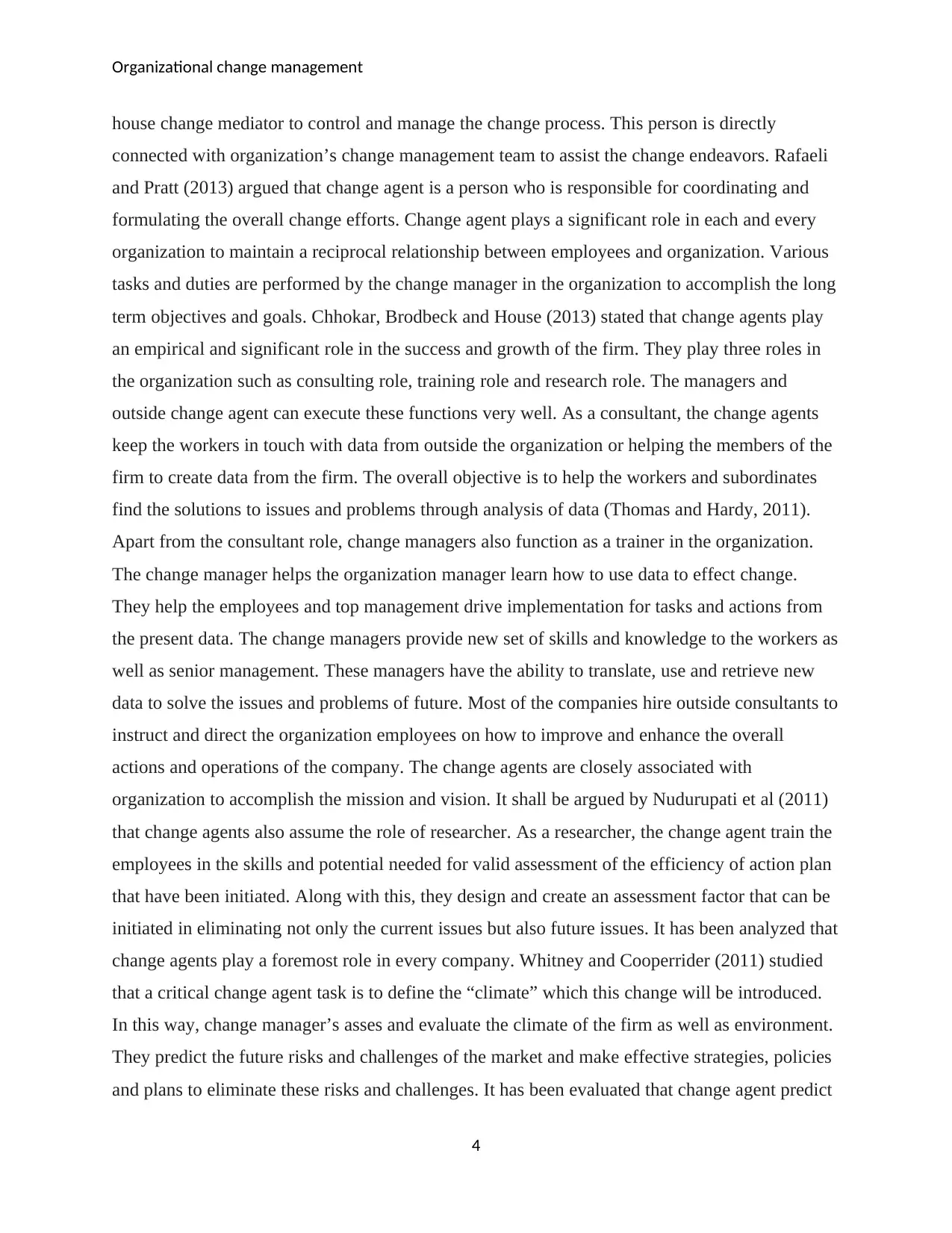
Organizational change management
house change mediator to control and manage the change process. This person is directly
connected with organization’s change management team to assist the change endeavors. Rafaeli
and Pratt (2013) argued that change agent is a person who is responsible for coordinating and
formulating the overall change efforts. Change agent plays a significant role in each and every
organization to maintain a reciprocal relationship between employees and organization. Various
tasks and duties are performed by the change manager in the organization to accomplish the long
term objectives and goals. Chhokar, Brodbeck and House (2013) stated that change agents play
an empirical and significant role in the success and growth of the firm. They play three roles in
the organization such as consulting role, training role and research role. The managers and
outside change agent can execute these functions very well. As a consultant, the change agents
keep the workers in touch with data from outside the organization or helping the members of the
firm to create data from the firm. The overall objective is to help the workers and subordinates
find the solutions to issues and problems through analysis of data (Thomas and Hardy, 2011).
Apart from the consultant role, change managers also function as a trainer in the organization.
The change manager helps the organization manager learn how to use data to effect change.
They help the employees and top management drive implementation for tasks and actions from
the present data. The change managers provide new set of skills and knowledge to the workers as
well as senior management. These managers have the ability to translate, use and retrieve new
data to solve the issues and problems of future. Most of the companies hire outside consultants to
instruct and direct the organization employees on how to improve and enhance the overall
actions and operations of the company. The change agents are closely associated with
organization to accomplish the mission and vision. It shall be argued by Nudurupati et al (2011)
that change agents also assume the role of researcher. As a researcher, the change agent train the
employees in the skills and potential needed for valid assessment of the efficiency of action plan
that have been initiated. Along with this, they design and create an assessment factor that can be
initiated in eliminating not only the current issues but also future issues. It has been analyzed that
change agents play a foremost role in every company. Whitney and Cooperrider (2011) studied
that a critical change agent task is to define the “climate” which this change will be introduced.
In this way, change manager’s asses and evaluate the climate of the firm as well as environment.
They predict the future risks and challenges of the market and make effective strategies, policies
and plans to eliminate these risks and challenges. It has been evaluated that change agent predict
4
house change mediator to control and manage the change process. This person is directly
connected with organization’s change management team to assist the change endeavors. Rafaeli
and Pratt (2013) argued that change agent is a person who is responsible for coordinating and
formulating the overall change efforts. Change agent plays a significant role in each and every
organization to maintain a reciprocal relationship between employees and organization. Various
tasks and duties are performed by the change manager in the organization to accomplish the long
term objectives and goals. Chhokar, Brodbeck and House (2013) stated that change agents play
an empirical and significant role in the success and growth of the firm. They play three roles in
the organization such as consulting role, training role and research role. The managers and
outside change agent can execute these functions very well. As a consultant, the change agents
keep the workers in touch with data from outside the organization or helping the members of the
firm to create data from the firm. The overall objective is to help the workers and subordinates
find the solutions to issues and problems through analysis of data (Thomas and Hardy, 2011).
Apart from the consultant role, change managers also function as a trainer in the organization.
The change manager helps the organization manager learn how to use data to effect change.
They help the employees and top management drive implementation for tasks and actions from
the present data. The change managers provide new set of skills and knowledge to the workers as
well as senior management. These managers have the ability to translate, use and retrieve new
data to solve the issues and problems of future. Most of the companies hire outside consultants to
instruct and direct the organization employees on how to improve and enhance the overall
actions and operations of the company. The change agents are closely associated with
organization to accomplish the mission and vision. It shall be argued by Nudurupati et al (2011)
that change agents also assume the role of researcher. As a researcher, the change agent train the
employees in the skills and potential needed for valid assessment of the efficiency of action plan
that have been initiated. Along with this, they design and create an assessment factor that can be
initiated in eliminating not only the current issues but also future issues. It has been analyzed that
change agents play a foremost role in every company. Whitney and Cooperrider (2011) studied
that a critical change agent task is to define the “climate” which this change will be introduced.
In this way, change manager’s asses and evaluate the climate of the firm as well as environment.
They predict the future risks and challenges of the market and make effective strategies, policies
and plans to eliminate these risks and challenges. It has been evaluated that change agent predict
4
Paraphrase This Document
Need a fresh take? Get an instant paraphrase of this document with our AI Paraphraser
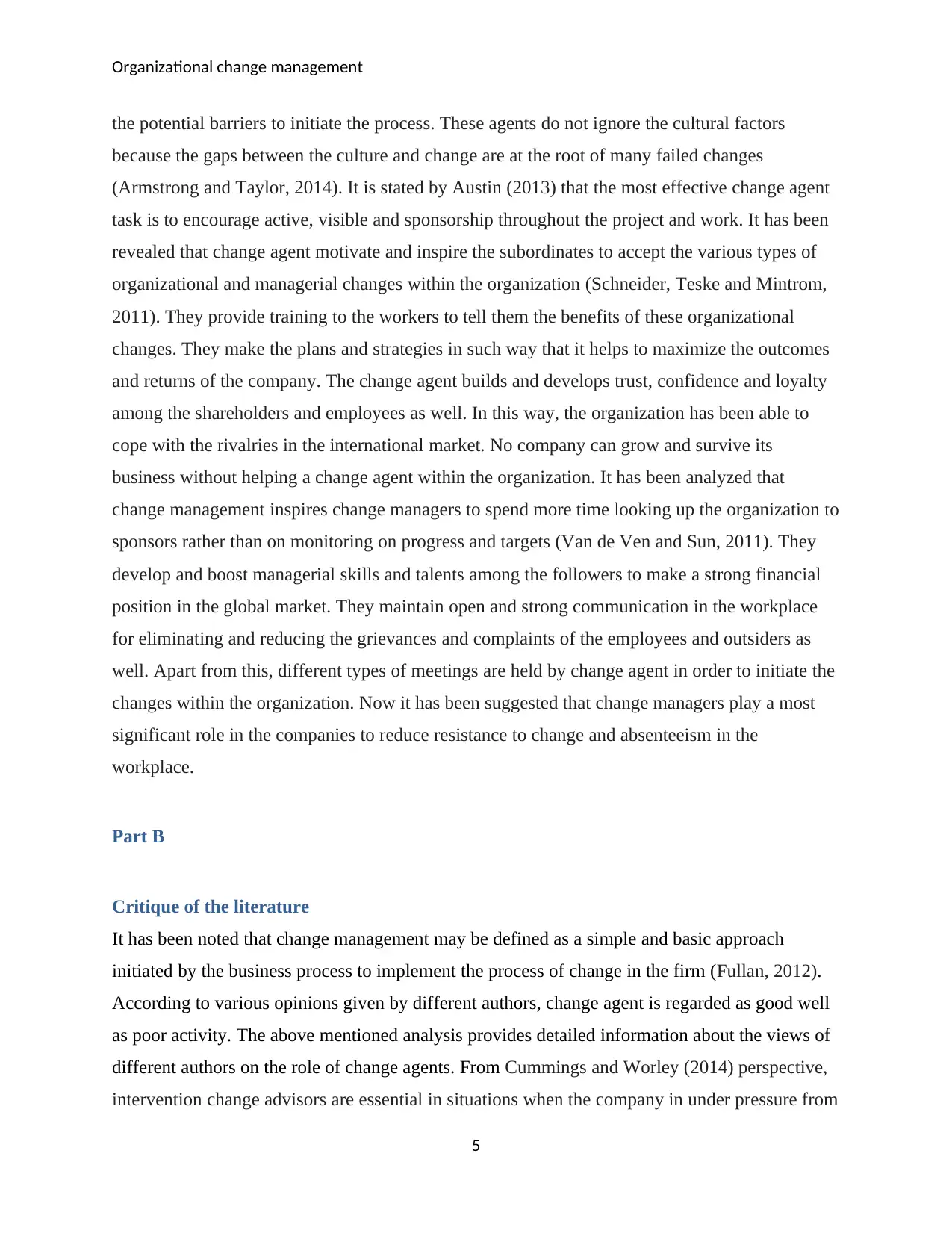
Organizational change management
the potential barriers to initiate the process. These agents do not ignore the cultural factors
because the gaps between the culture and change are at the root of many failed changes
(Armstrong and Taylor, 2014). It is stated by Austin (2013) that the most effective change agent
task is to encourage active, visible and sponsorship throughout the project and work. It has been
revealed that change agent motivate and inspire the subordinates to accept the various types of
organizational and managerial changes within the organization (Schneider, Teske and Mintrom,
2011). They provide training to the workers to tell them the benefits of these organizational
changes. They make the plans and strategies in such way that it helps to maximize the outcomes
and returns of the company. The change agent builds and develops trust, confidence and loyalty
among the shareholders and employees as well. In this way, the organization has been able to
cope with the rivalries in the international market. No company can grow and survive its
business without helping a change agent within the organization. It has been analyzed that
change management inspires change managers to spend more time looking up the organization to
sponsors rather than on monitoring on progress and targets (Van de Ven and Sun, 2011). They
develop and boost managerial skills and talents among the followers to make a strong financial
position in the global market. They maintain open and strong communication in the workplace
for eliminating and reducing the grievances and complaints of the employees and outsiders as
well. Apart from this, different types of meetings are held by change agent in order to initiate the
changes within the organization. Now it has been suggested that change managers play a most
significant role in the companies to reduce resistance to change and absenteeism in the
workplace.
Part B
Critique of the literature
It has been noted that change management may be defined as a simple and basic approach
initiated by the business process to implement the process of change in the firm (Fullan, 2012).
According to various opinions given by different authors, change agent is regarded as good well
as poor activity. The above mentioned analysis provides detailed information about the views of
different authors on the role of change agents. From Cummings and Worley (2014) perspective,
intervention change advisors are essential in situations when the company in under pressure from
5
the potential barriers to initiate the process. These agents do not ignore the cultural factors
because the gaps between the culture and change are at the root of many failed changes
(Armstrong and Taylor, 2014). It is stated by Austin (2013) that the most effective change agent
task is to encourage active, visible and sponsorship throughout the project and work. It has been
revealed that change agent motivate and inspire the subordinates to accept the various types of
organizational and managerial changes within the organization (Schneider, Teske and Mintrom,
2011). They provide training to the workers to tell them the benefits of these organizational
changes. They make the plans and strategies in such way that it helps to maximize the outcomes
and returns of the company. The change agent builds and develops trust, confidence and loyalty
among the shareholders and employees as well. In this way, the organization has been able to
cope with the rivalries in the international market. No company can grow and survive its
business without helping a change agent within the organization. It has been analyzed that
change management inspires change managers to spend more time looking up the organization to
sponsors rather than on monitoring on progress and targets (Van de Ven and Sun, 2011). They
develop and boost managerial skills and talents among the followers to make a strong financial
position in the global market. They maintain open and strong communication in the workplace
for eliminating and reducing the grievances and complaints of the employees and outsiders as
well. Apart from this, different types of meetings are held by change agent in order to initiate the
changes within the organization. Now it has been suggested that change managers play a most
significant role in the companies to reduce resistance to change and absenteeism in the
workplace.
Part B
Critique of the literature
It has been noted that change management may be defined as a simple and basic approach
initiated by the business process to implement the process of change in the firm (Fullan, 2012).
According to various opinions given by different authors, change agent is regarded as good well
as poor activity. The above mentioned analysis provides detailed information about the views of
different authors on the role of change agents. From Cummings and Worley (2014) perspective,
intervention change advisors are essential in situations when the company in under pressure from
5
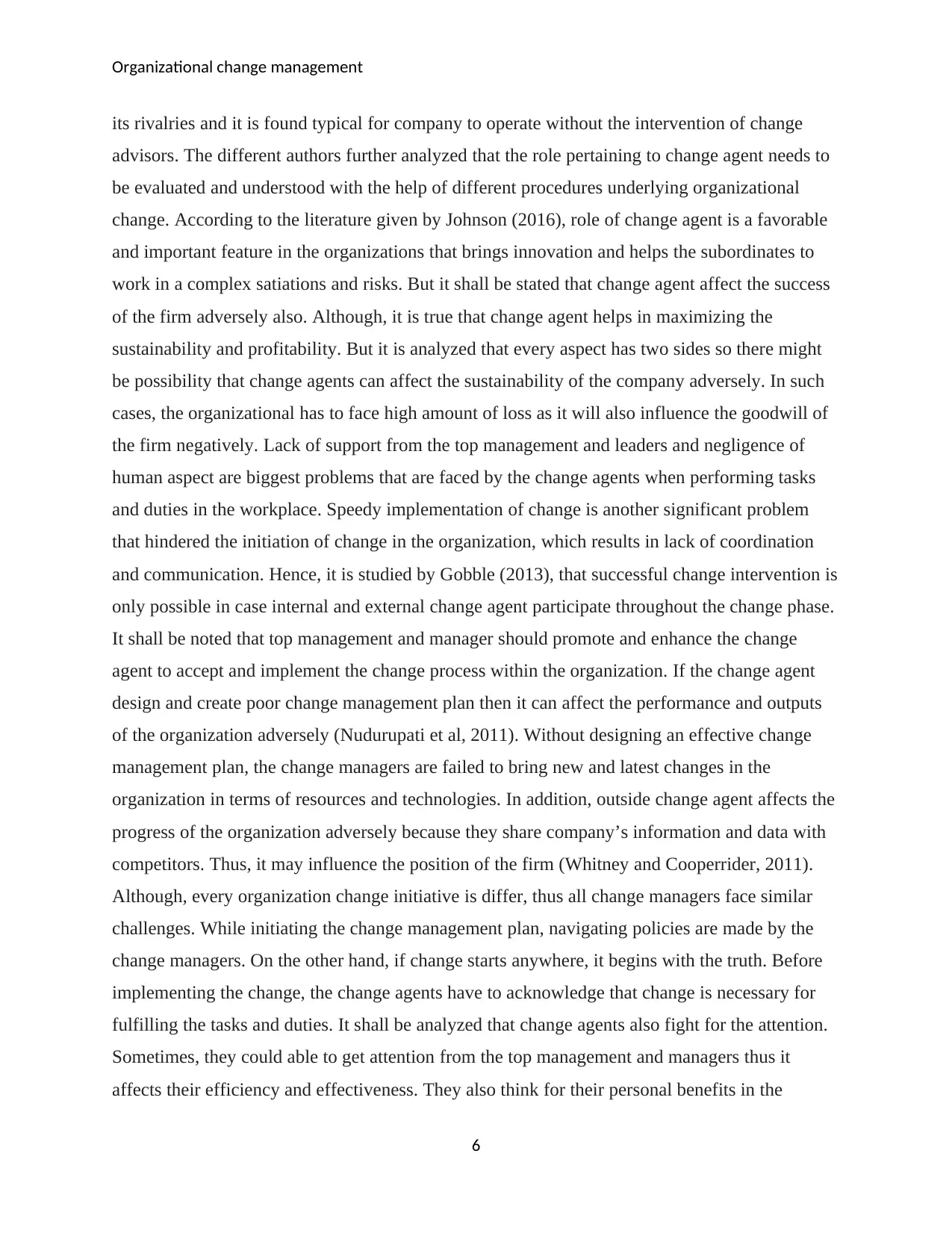
Organizational change management
its rivalries and it is found typical for company to operate without the intervention of change
advisors. The different authors further analyzed that the role pertaining to change agent needs to
be evaluated and understood with the help of different procedures underlying organizational
change. According to the literature given by Johnson (2016), role of change agent is a favorable
and important feature in the organizations that brings innovation and helps the subordinates to
work in a complex satiations and risks. But it shall be stated that change agent affect the success
of the firm adversely also. Although, it is true that change agent helps in maximizing the
sustainability and profitability. But it is analyzed that every aspect has two sides so there might
be possibility that change agents can affect the sustainability of the company adversely. In such
cases, the organizational has to face high amount of loss as it will also influence the goodwill of
the firm negatively. Lack of support from the top management and leaders and negligence of
human aspect are biggest problems that are faced by the change agents when performing tasks
and duties in the workplace. Speedy implementation of change is another significant problem
that hindered the initiation of change in the organization, which results in lack of coordination
and communication. Hence, it is studied by Gobble (2013), that successful change intervention is
only possible in case internal and external change agent participate throughout the change phase.
It shall be noted that top management and manager should promote and enhance the change
agent to accept and implement the change process within the organization. If the change agent
design and create poor change management plan then it can affect the performance and outputs
of the organization adversely (Nudurupati et al, 2011). Without designing an effective change
management plan, the change managers are failed to bring new and latest changes in the
organization in terms of resources and technologies. In addition, outside change agent affects the
progress of the organization adversely because they share company’s information and data with
competitors. Thus, it may influence the position of the firm (Whitney and Cooperrider, 2011).
Although, every organization change initiative is differ, thus all change managers face similar
challenges. While initiating the change management plan, navigating policies are made by the
change managers. On the other hand, if change starts anywhere, it begins with the truth. Before
implementing the change, the change agents have to acknowledge that change is necessary for
fulfilling the tasks and duties. It shall be analyzed that change agents also fight for the attention.
Sometimes, they could able to get attention from the top management and managers thus it
affects their efficiency and effectiveness. They also think for their personal benefits in the
6
its rivalries and it is found typical for company to operate without the intervention of change
advisors. The different authors further analyzed that the role pertaining to change agent needs to
be evaluated and understood with the help of different procedures underlying organizational
change. According to the literature given by Johnson (2016), role of change agent is a favorable
and important feature in the organizations that brings innovation and helps the subordinates to
work in a complex satiations and risks. But it shall be stated that change agent affect the success
of the firm adversely also. Although, it is true that change agent helps in maximizing the
sustainability and profitability. But it is analyzed that every aspect has two sides so there might
be possibility that change agents can affect the sustainability of the company adversely. In such
cases, the organizational has to face high amount of loss as it will also influence the goodwill of
the firm negatively. Lack of support from the top management and leaders and negligence of
human aspect are biggest problems that are faced by the change agents when performing tasks
and duties in the workplace. Speedy implementation of change is another significant problem
that hindered the initiation of change in the organization, which results in lack of coordination
and communication. Hence, it is studied by Gobble (2013), that successful change intervention is
only possible in case internal and external change agent participate throughout the change phase.
It shall be noted that top management and manager should promote and enhance the change
agent to accept and implement the change process within the organization. If the change agent
design and create poor change management plan then it can affect the performance and outputs
of the organization adversely (Nudurupati et al, 2011). Without designing an effective change
management plan, the change managers are failed to bring new and latest changes in the
organization in terms of resources and technologies. In addition, outside change agent affects the
progress of the organization adversely because they share company’s information and data with
competitors. Thus, it may influence the position of the firm (Whitney and Cooperrider, 2011).
Although, every organization change initiative is differ, thus all change managers face similar
challenges. While initiating the change management plan, navigating policies are made by the
change managers. On the other hand, if change starts anywhere, it begins with the truth. Before
implementing the change, the change agents have to acknowledge that change is necessary for
fulfilling the tasks and duties. It shall be analyzed that change agents also fight for the attention.
Sometimes, they could able to get attention from the top management and managers thus it
affects their efficiency and effectiveness. They also think for their personal benefits in the
6
⊘ This is a preview!⊘
Do you want full access?
Subscribe today to unlock all pages.

Trusted by 1+ million students worldwide
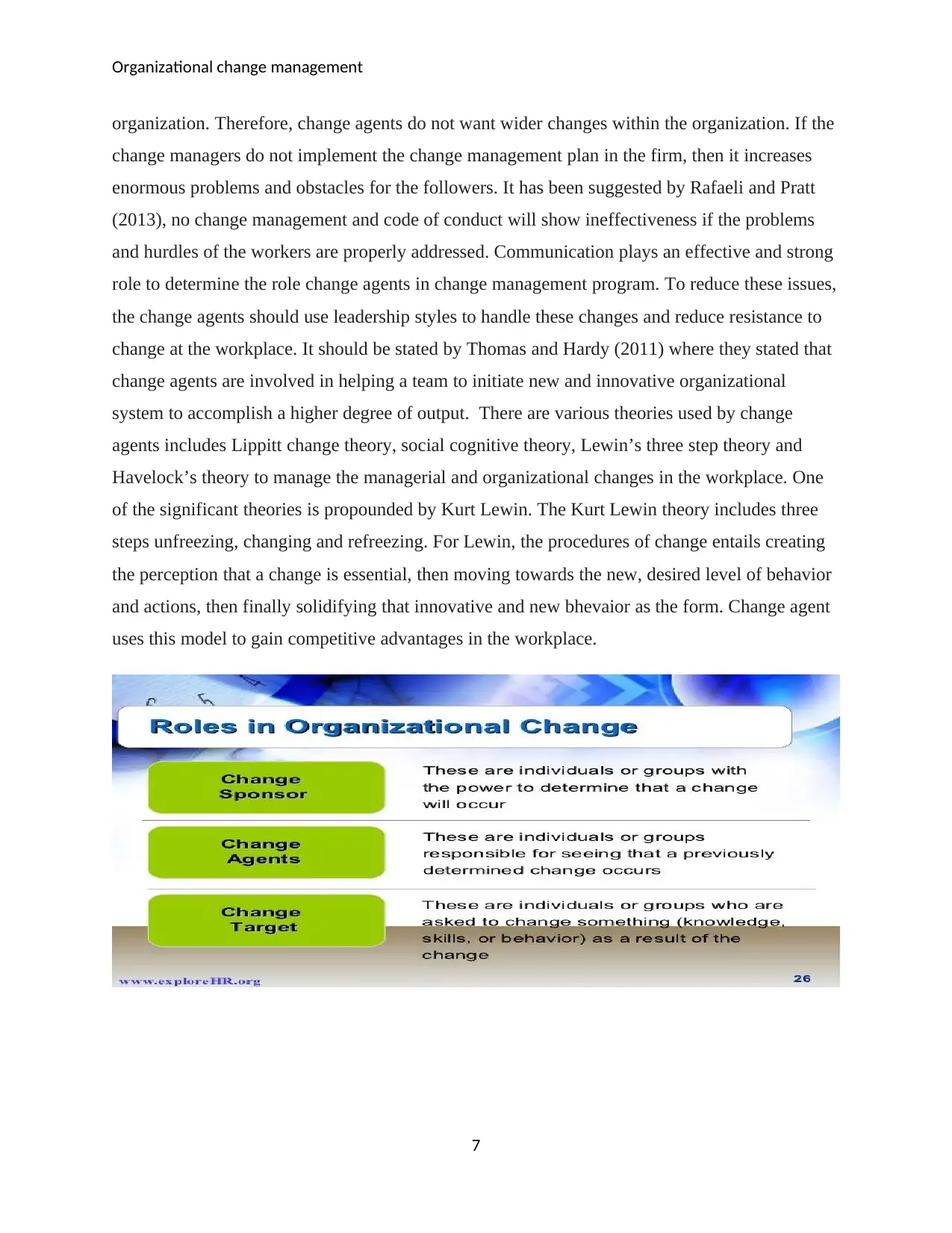
Organizational change management
organization. Therefore, change agents do not want wider changes within the organization. If the
change managers do not implement the change management plan in the firm, then it increases
enormous problems and obstacles for the followers. It has been suggested by Rafaeli and Pratt
(2013), no change management and code of conduct will show ineffectiveness if the problems
and hurdles of the workers are properly addressed. Communication plays an effective and strong
role to determine the role change agents in change management program. To reduce these issues,
the change agents should use leadership styles to handle these changes and reduce resistance to
change at the workplace. It should be stated by Thomas and Hardy (2011) where they stated that
change agents are involved in helping a team to initiate new and innovative organizational
system to accomplish a higher degree of output. There are various theories used by change
agents includes Lippitt change theory, social cognitive theory, Lewin’s three step theory and
Havelock’s theory to manage the managerial and organizational changes in the workplace. One
of the significant theories is propounded by Kurt Lewin. The Kurt Lewin theory includes three
steps unfreezing, changing and refreezing. For Lewin, the procedures of change entails creating
the perception that a change is essential, then moving towards the new, desired level of behavior
and actions, then finally solidifying that innovative and new bhevaior as the form. Change agent
uses this model to gain competitive advantages in the workplace.
7
organization. Therefore, change agents do not want wider changes within the organization. If the
change managers do not implement the change management plan in the firm, then it increases
enormous problems and obstacles for the followers. It has been suggested by Rafaeli and Pratt
(2013), no change management and code of conduct will show ineffectiveness if the problems
and hurdles of the workers are properly addressed. Communication plays an effective and strong
role to determine the role change agents in change management program. To reduce these issues,
the change agents should use leadership styles to handle these changes and reduce resistance to
change at the workplace. It should be stated by Thomas and Hardy (2011) where they stated that
change agents are involved in helping a team to initiate new and innovative organizational
system to accomplish a higher degree of output. There are various theories used by change
agents includes Lippitt change theory, social cognitive theory, Lewin’s three step theory and
Havelock’s theory to manage the managerial and organizational changes in the workplace. One
of the significant theories is propounded by Kurt Lewin. The Kurt Lewin theory includes three
steps unfreezing, changing and refreezing. For Lewin, the procedures of change entails creating
the perception that a change is essential, then moving towards the new, desired level of behavior
and actions, then finally solidifying that innovative and new bhevaior as the form. Change agent
uses this model to gain competitive advantages in the workplace.
7
Paraphrase This Document
Need a fresh take? Get an instant paraphrase of this document with our AI Paraphraser
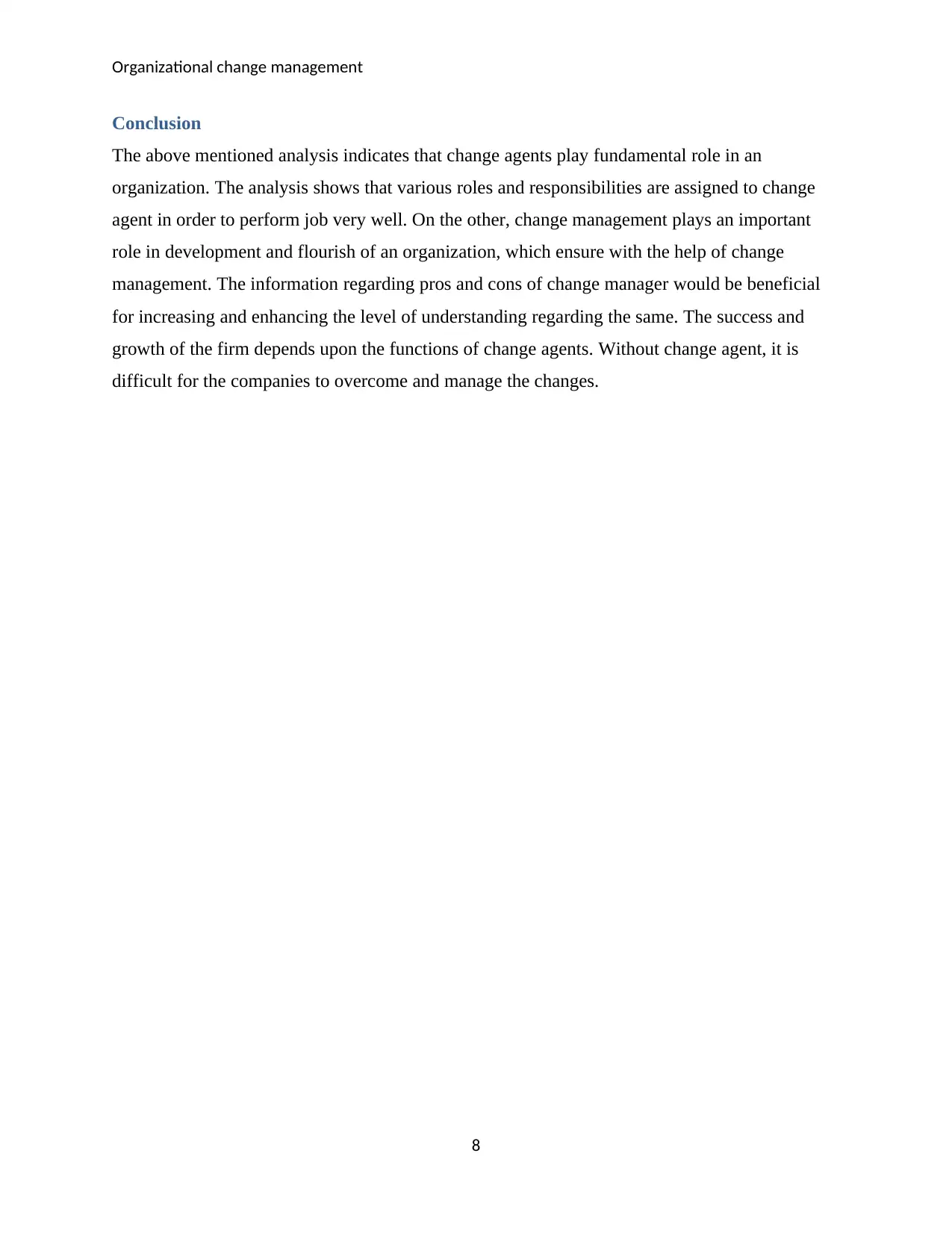
Organizational change management
Conclusion
The above mentioned analysis indicates that change agents play fundamental role in an
organization. The analysis shows that various roles and responsibilities are assigned to change
agent in order to perform job very well. On the other, change management plays an important
role in development and flourish of an organization, which ensure with the help of change
management. The information regarding pros and cons of change manager would be beneficial
for increasing and enhancing the level of understanding regarding the same. The success and
growth of the firm depends upon the functions of change agents. Without change agent, it is
difficult for the companies to overcome and manage the changes.
8
Conclusion
The above mentioned analysis indicates that change agents play fundamental role in an
organization. The analysis shows that various roles and responsibilities are assigned to change
agent in order to perform job very well. On the other, change management plays an important
role in development and flourish of an organization, which ensure with the help of change
management. The information regarding pros and cons of change manager would be beneficial
for increasing and enhancing the level of understanding regarding the same. The success and
growth of the firm depends upon the functions of change agents. Without change agent, it is
difficult for the companies to overcome and manage the changes.
8
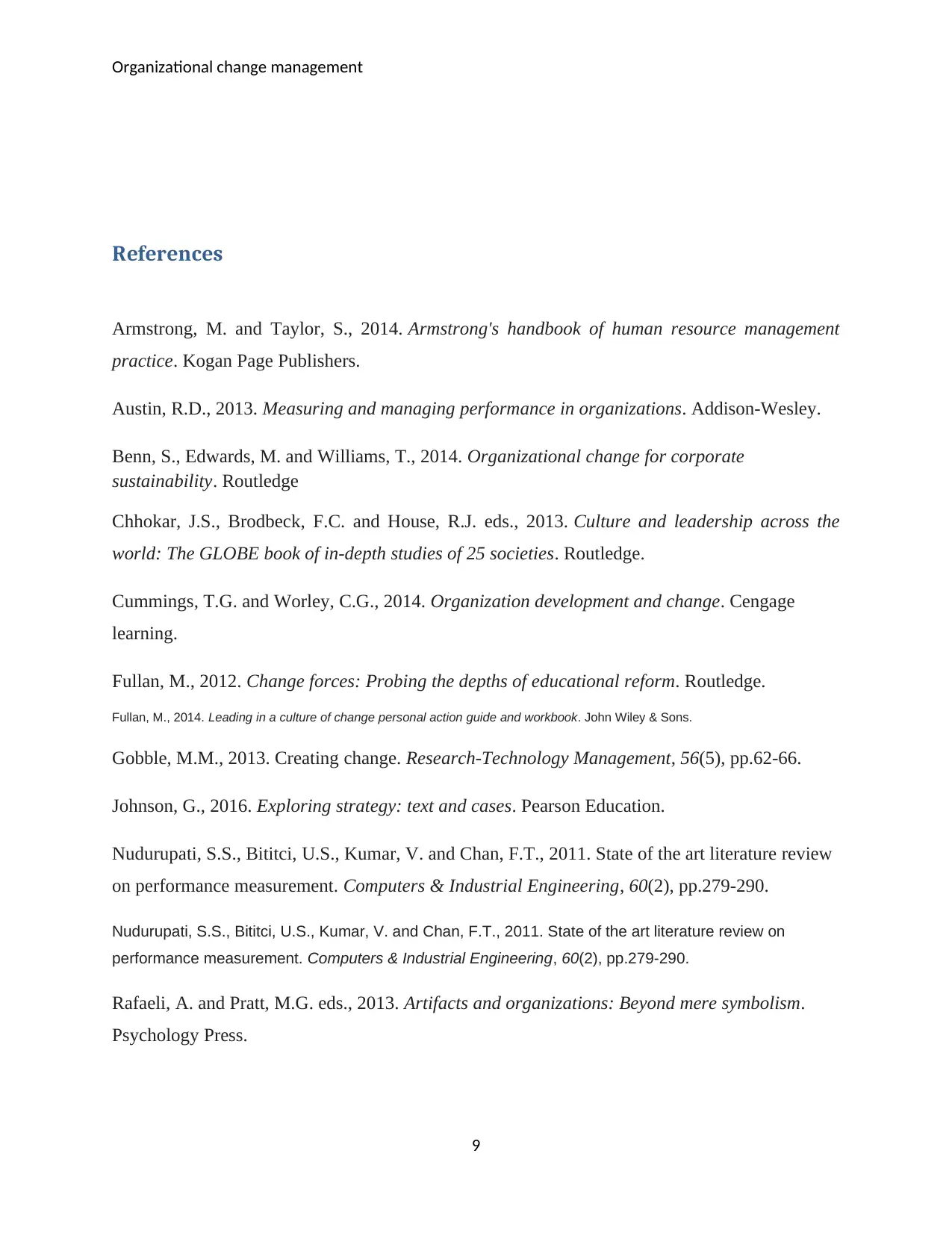
Organizational change management
References
Armstrong, M. and Taylor, S., 2014. Armstrong's handbook of human resource management
practice. Kogan Page Publishers.
Austin, R.D., 2013. Measuring and managing performance in organizations. Addison-Wesley.
Benn, S., Edwards, M. and Williams, T., 2014. Organizational change for corporate
sustainability. Routledge
Chhokar, J.S., Brodbeck, F.C. and House, R.J. eds., 2013. Culture and leadership across the
world: The GLOBE book of in-depth studies of 25 societies. Routledge.
Cummings, T.G. and Worley, C.G., 2014. Organization development and change. Cengage
learning.
Fullan, M., 2012. Change forces: Probing the depths of educational reform. Routledge.
Fullan, M., 2014. Leading in a culture of change personal action guide and workbook. John Wiley & Sons.
Gobble, M.M., 2013. Creating change. Research-Technology Management, 56(5), pp.62-66.
Johnson, G., 2016. Exploring strategy: text and cases. Pearson Education.
Nudurupati, S.S., Bititci, U.S., Kumar, V. and Chan, F.T., 2011. State of the art literature review
on performance measurement. Computers & Industrial Engineering, 60(2), pp.279-290.
Nudurupati, S.S., Bititci, U.S., Kumar, V. and Chan, F.T., 2011. State of the art literature review on
performance measurement. Computers & Industrial Engineering, 60(2), pp.279-290.
Rafaeli, A. and Pratt, M.G. eds., 2013. Artifacts and organizations: Beyond mere symbolism.
Psychology Press.
9
References
Armstrong, M. and Taylor, S., 2014. Armstrong's handbook of human resource management
practice. Kogan Page Publishers.
Austin, R.D., 2013. Measuring and managing performance in organizations. Addison-Wesley.
Benn, S., Edwards, M. and Williams, T., 2014. Organizational change for corporate
sustainability. Routledge
Chhokar, J.S., Brodbeck, F.C. and House, R.J. eds., 2013. Culture and leadership across the
world: The GLOBE book of in-depth studies of 25 societies. Routledge.
Cummings, T.G. and Worley, C.G., 2014. Organization development and change. Cengage
learning.
Fullan, M., 2012. Change forces: Probing the depths of educational reform. Routledge.
Fullan, M., 2014. Leading in a culture of change personal action guide and workbook. John Wiley & Sons.
Gobble, M.M., 2013. Creating change. Research-Technology Management, 56(5), pp.62-66.
Johnson, G., 2016. Exploring strategy: text and cases. Pearson Education.
Nudurupati, S.S., Bititci, U.S., Kumar, V. and Chan, F.T., 2011. State of the art literature review
on performance measurement. Computers & Industrial Engineering, 60(2), pp.279-290.
Nudurupati, S.S., Bititci, U.S., Kumar, V. and Chan, F.T., 2011. State of the art literature review on
performance measurement. Computers & Industrial Engineering, 60(2), pp.279-290.
Rafaeli, A. and Pratt, M.G. eds., 2013. Artifacts and organizations: Beyond mere symbolism.
Psychology Press.
9
⊘ This is a preview!⊘
Do you want full access?
Subscribe today to unlock all pages.

Trusted by 1+ million students worldwide
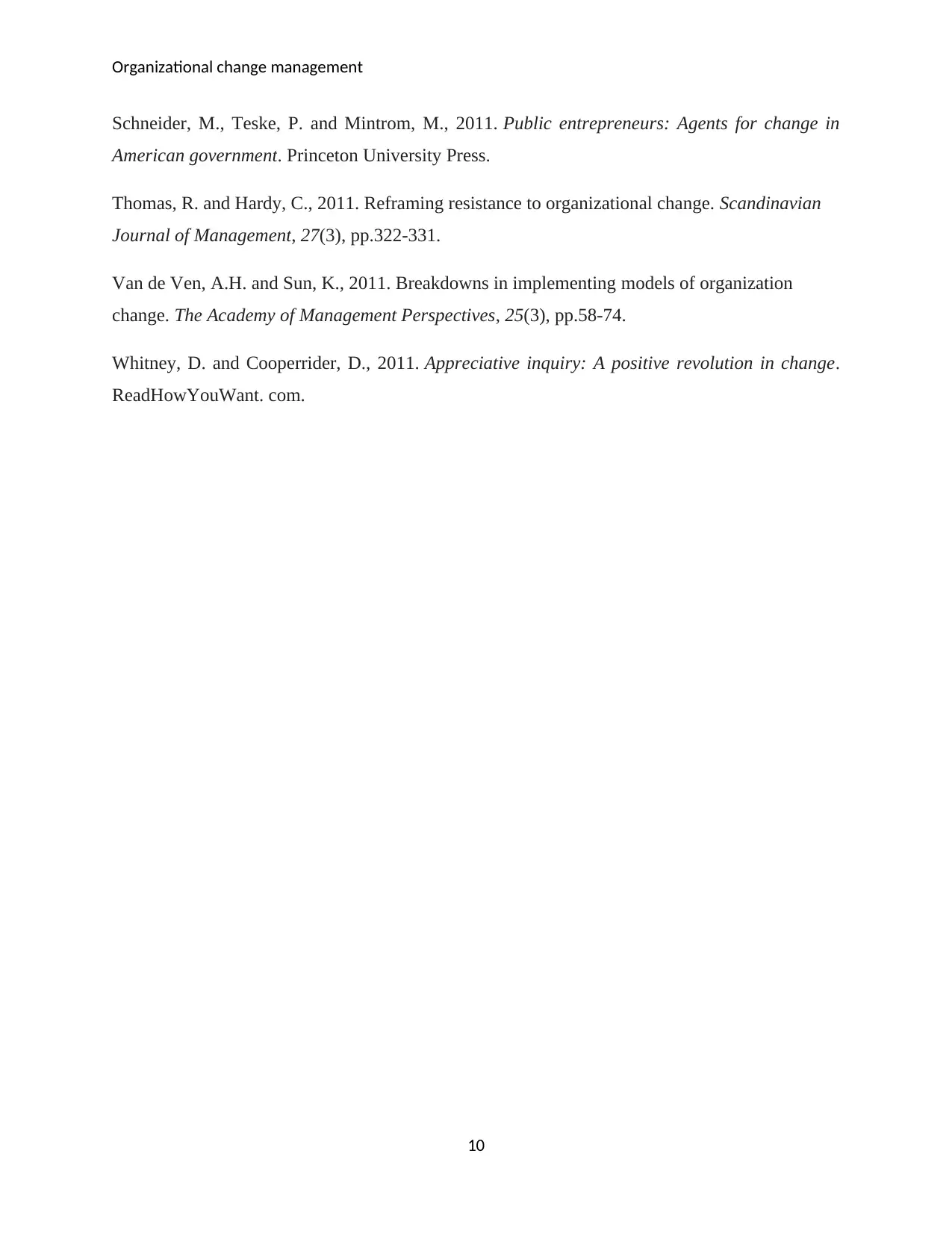
Organizational change management
Schneider, M., Teske, P. and Mintrom, M., 2011. Public entrepreneurs: Agents for change in
American government. Princeton University Press.
Thomas, R. and Hardy, C., 2011. Reframing resistance to organizational change. Scandinavian
Journal of Management, 27(3), pp.322-331.
Van de Ven, A.H. and Sun, K., 2011. Breakdowns in implementing models of organization
change. The Academy of Management Perspectives, 25(3), pp.58-74.
Whitney, D. and Cooperrider, D., 2011. Appreciative inquiry: A positive revolution in change.
ReadHowYouWant. com.
10
Schneider, M., Teske, P. and Mintrom, M., 2011. Public entrepreneurs: Agents for change in
American government. Princeton University Press.
Thomas, R. and Hardy, C., 2011. Reframing resistance to organizational change. Scandinavian
Journal of Management, 27(3), pp.322-331.
Van de Ven, A.H. and Sun, K., 2011. Breakdowns in implementing models of organization
change. The Academy of Management Perspectives, 25(3), pp.58-74.
Whitney, D. and Cooperrider, D., 2011. Appreciative inquiry: A positive revolution in change.
ReadHowYouWant. com.
10
1 out of 10
Related Documents
Your All-in-One AI-Powered Toolkit for Academic Success.
+13062052269
info@desklib.com
Available 24*7 on WhatsApp / Email
![[object Object]](/_next/static/media/star-bottom.7253800d.svg)
Unlock your academic potential
Copyright © 2020–2025 A2Z Services. All Rights Reserved. Developed and managed by ZUCOL.




